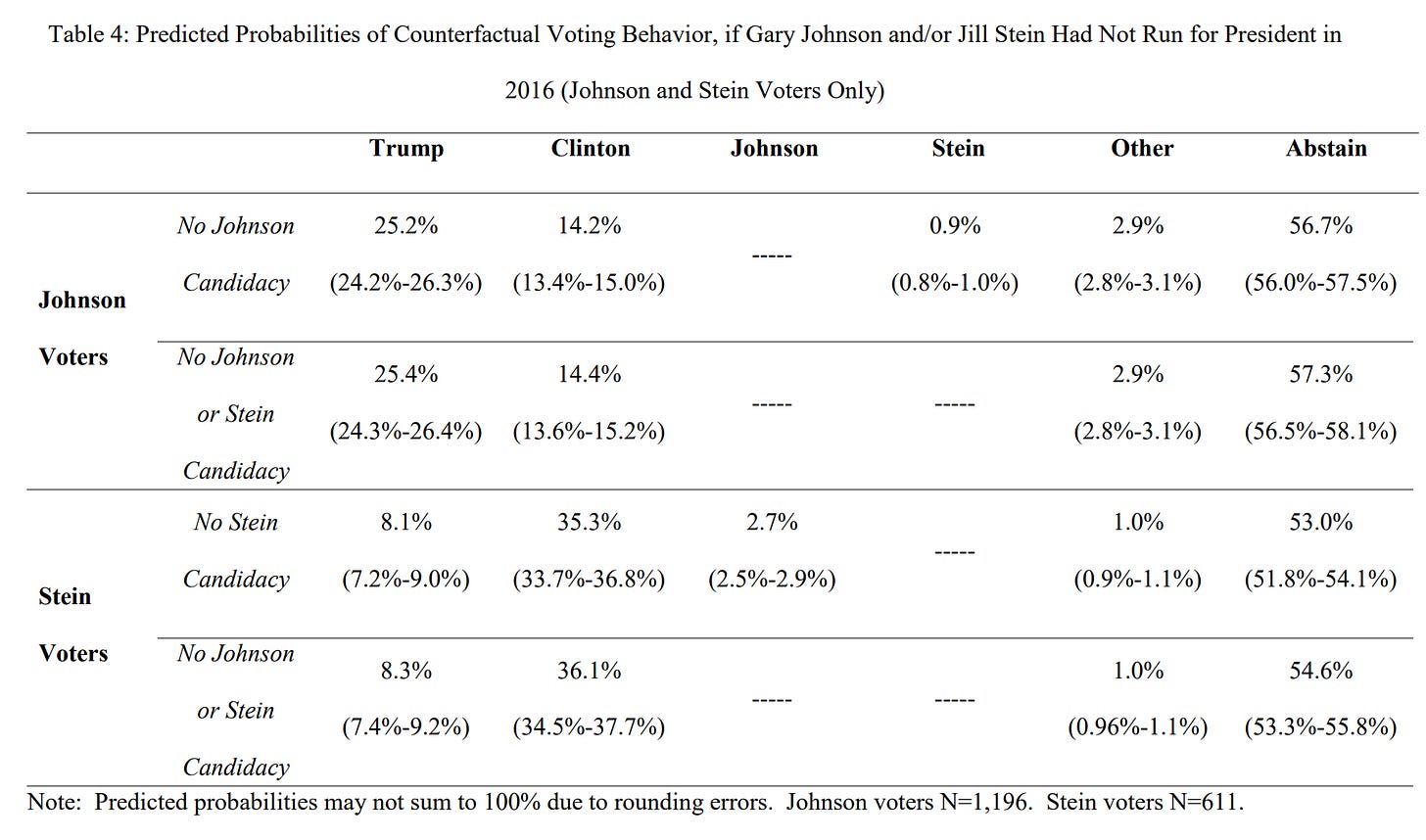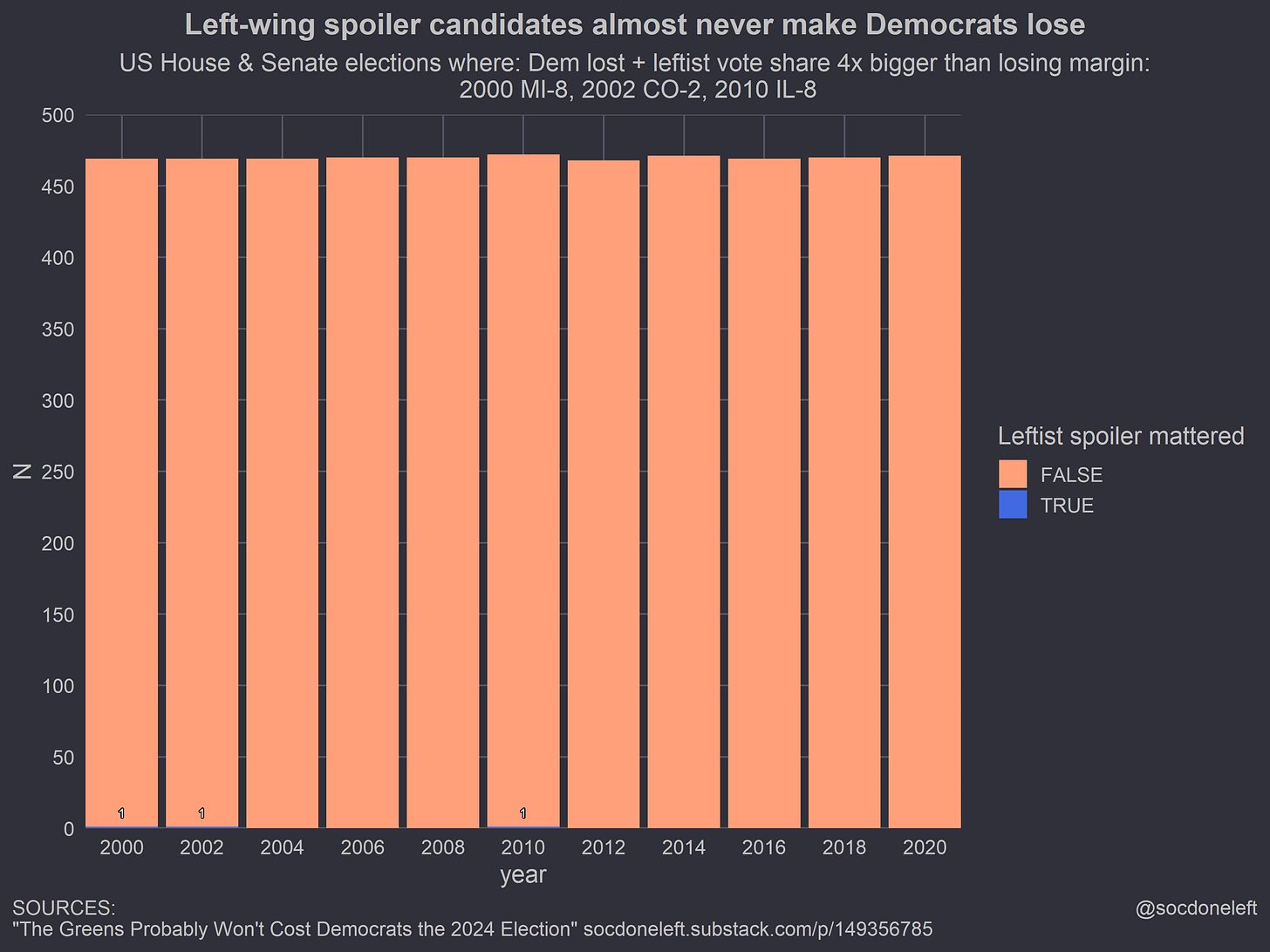Jill Stein Probably Won't Cost Democrats the 2024 Election
Or: The spoiler effect from the Greens is very real, very small, and almost never important.
This article continues themes from “Socialists will overwhelmingly vote for Kamala Harris” and “The Green Party Almost Always Loses”.
Anti-left Democrats and anti-Dem leftists agree: Jill Stein threatens Democratic victory.
If Harris loses, these centrists will blame Greens for spoiling and these leftists will blame Dems for shifting right.
Both sides implicitly agree that leftist voters, stuck choosing between a good Green and a bad Democrat, will decide who wins in 2024.
They’re both wrong. In reality:
Most Green voters would NOT vote Democrat if the Green party refused to run.
Green candidates ARE spoilers, but Green spoiling ALMOST NEVER changes election results.
FEWER people will vote Green in 2024 than in 2020.
As a result, Green margins will likely NOT be large enough to sway the election.
This article will justify each claim above.
0. Leftists and centrists agree: The left is very important
Both anti-left Democrats and anti-Democrat leftists agree: The Green Party presidential candidate Jill Stein is a threat to Kamala Harris’s presidential campaign.
Anti-left Democrats argue that Stein is risking a Democratic defeat because they are a Republican stooge who is running to help Trump win. Examples:
Democratic National Committee spokesperson Matt Corridoni, 1.5k likes: “Stein is a spoiler. Propped up by the Kremlin in 2016 & propped up by the GOP now.”
Former Buttigieg strategist Lis Smith, 24k likes: “Stein doesn’t know how many members of the House there are in Congress. [….] Just the latest sign she’s a deeply unserious candidate only there to help Trump win.”
Liberal pundit Dan Savage[1], 19k likes: “A vote for Stein is a vote for Trump.”
Clearly, these views are popular among anti-left Democrats.
Anti-Democrat leftists argue that Jill Stein should steal votes from the Democrats, because the Democrats ought to lose. Examples:
Green perennial candidate Jill Stein, 23k likes: “What’s the value of Democrats winning if you won’t fight for [list of good policies]? [….] Maybe it’s time to watch these parties die.”
Socialist pundit DoctorFishbones, 8.3k likes: “I’m voting for Jill Stein because I want Kamala to lose because of her support for Israel”
Socialist pundit Nick Cruse (SocialistMMA), 15k likes: “I really hope Jill Stein costs Kamala Harris the election so we can rub it in AOC face for 4 years”
Clearly, these views are popular among anti-Democrat leftists.
This narrative is very convenient for both camps. Anti-left centrists use it to justify bashing leftists (because they will waste votes and make the right win elections). Anti-Dem leftists use it to justify running Green candidates (because that will force Dems to shift left or lose).
They’re both wrong.
In short: Both anti-left Democrats and anti-Democrat leftists agree that the Green Party can spoil the election and prevent Democrats from taking power. They just disagree on whether this would be good or bad.
1. Most Green voters would not vote Democrat
When C-SPAN interviewed Jill Stein last month, they rejected the idea that Greens are “spoiler” candidates:
First, about the spoiler [effect], that is part of Democrat propaganda. Polls showed completely – as well as talking to people – that people who voted Green would otherwise not have voted. What my campaign does is allow people to vote, who otherwise do not have a voice in the election.
Stein is half right and half wrong:
Stein is right to imply that MOST Green voters would abstain without a Green choice.
Stein is wrong to imply that ALL Green voters would abstain.
Without a Green candidate, about 60% of Green voters would have abstained. The other 40% would have voted for their second-favorite candidate, overwhelmingly the Democrat.
How do we know that?
The Cooperative Election Study (CES or CCES) is a massive sample (50,000 people) of verified voters (usually matched to a public voter file by Catalist). This makes it excellent for answering how verified 3rd-party voters would have voted if the Green Party wasn’t on the ballot.
Devine and Kopko 2021 (PDF) did just that. Using the 2016 CES, they estimated a model of voter behavior from demographics and their political views. Rephrased, Devine and Kopko 2021’s formula predicts your vote from your identity and your ideology.
For two-party voters, this kind of prediction is pretty easy. With just three-to-eight questions about your identity, you can offer very strong predictions of whether someone is a Democrat or Republican. It’s much harder to model third-party voters: They’re a much smaller group with much weirder ideological-demographic profiles. Many Greens look like leftist Democrats, but many Greens look like centrists.
With those caveats: Devine and Kopko’s formula offers one of the better ways to to answer the question: “How would a Green voter vote, if no Green was on the ballot?”
Devine and Kopko 2021’s formula predicts that, if no Green candidate appeared on the ballot, 53.0% of Green voters would abstain, 35.3% vote Clinton, 8.1% Trump, and 2.7% Johnson. (Put another way: Among the non-abstaining 47% that would still vote, 75% would vote Clinton and 17% Trump.) If we accept these proportions, then the net gain for Clinton from a Green disappearance would be just 27.2% of the Green vote.
This may seem like a high proportion of Trump voters. In fact, Herron and Lewis 2007 (PDF) found that, based on downballot voting patterns, in a Nader-less world, ~35% of Nader voters would have voted for Bush! (As mentioned above: Many Green voters look like centrists.)
In short: Most Green voters would NOT vote Democrat if the Green party refused to run. Without a Green ballot option, about 65% of Greens would not vote, 35% vote Dem, and 10% vote Rep.
2. Greens are spoilers, but it almost never matters
Section 1 above shows that Greens ARE spoilers – about 1/3 of Greens would have voted Dem otherwise – but also that Greens are much weaker spoilers than their vote share implies.
Devine and Kopko 2021’s results suggest a simple rule of thumb: Compare the Green vote share divided by 4 (or multiplied by 25%) against the two-party margin (Democratic vote share minus Republican vote share). If the adjusted Green vote share is smaller, then Green spoiling had no effect. If the adjusted Green vote share is larger, then Greens spoiled the election.
In practice, Green spoiling almost never changes the election result. Greens DID spoil the 2000 presidential election – as Herron and Lewis 2007 prove – but only because the 2000 Florida presidential election was incredibly close:
Rep share: 48.847%
Dem share: 48.838%
Two-party margin: 0.009%
Green share: 1.635%
Divided by four: 0.409%
Conclusion: ✅ big enough to spoil
In contrast, the Greens did NOT spoil the 2016 presidential election. Greens DID spoil the very close election in Michigan – as Devine and Kopko 2021 show – but did NOT change the election results, because Clinton also needed to win Wisconsin and Pennsylvania. Take the 2016 Pennsylvania presidential election, the second-closest state:
Rep share: 48.183%
Dem share: 47.465%
Two-party margin: 0.718%
Green share: 0.810%
Divided by four: 0.203%
Conclusion: ❌ NOT big enough to spoil
It’s not just presidential elections. Very few Democratic victories are spoiled by leftist candidates (including both Greens and a dozen tiny leftist parties).
Out of ~6,100 House and Senate elections from 2000 to 2020, just 7 elections (or 1 in ~900) saw a Democrat lose with a smaller margin than the leftist vote share – and just 4 elections (or 1 in ~1500) would pass the rule of thumb above:
2022 MI-10: 🟨 roughly big enough
Rep 48.80%, Dem 48.31%, two-party margin: ~0.49%
Working Class Party 1.81%, divided by four: ~0.45%
2012 MI-1: ❌ not big enough
Rep 48.14%, Dem 47.60%, two-party margin: ~0.54%
Green 1.20%, divided by four: ~0.30%
2010 IL-8: ✅ big enough
Rep 48.47%, Dem 48.32%, two-party margin: ~0.15%
Green 3.21%, divided by four: ~0.80%
2010 IL-SEN: ❌ not big enough
Rep 48.01%, Dem 46.42%, two-party margin: ~1.59%
Green 3.18%, divided by four: ~0.80%
2008 LA-2: ❌ not big enough
Rep 49.54%, Dem 46.81%, two-party margin: ~2.73%
Green 2.81%, divided by four: ~0.70%
2002 CO-2: ✅ big enough
Rep 47.31%, Dem 47.24%, two-party margin: ~0.07%
Green 1.89%, divided by four: ~0.47%
2000 MI-8: ✅ big enough
Rep 48.79%, Dem 48.75%, two-party margin: ~0.04%
Green: 1.17%, divided by four: ~0.29%
Here’s what the Congress results for 2000-20 look like on a graph:
Leftist spoiling is very rare. However, it is also real:
The Green Party ran in 788 federal elections from 2000 to 2022. Green candidates won 0 elections but spoiled 4 elections. Put another way: For every 197 federal Green candidates, 197 (100%) lost, and 1 (0.51%) spoiled a Democrat (which made a Republican win).
The Working Class Party ran in 23 federal elections from 2014 to 2022. WCP candidates won 0 elections but spoiled 1 election. Put another way: For every 23 federal WCP candidates, 23 (100%) lost, and 1 (4.35%) spoiled a Democrat (which made a Republican win).
These are pathetic outcomes. If your strategy has 0 victories AND has made the worse alternative win ~1 in 100 times, it's a failed strategy.
In short: Green candidates ARE spoilers, but Green spoiling ALMOST NEVER changes election results. Because the Green spoiling effect is 4 times smaller than the Green vote share, Green spoiling affected just 5 federal elections in the past 24 years.
3. Fewer people will vote Green in 2024
Third party candidates routinely underperform their polling. Pew Research found that, across the ideological spectrum, polls predicted that third party candidates would do better than they actually did:
Green candidate Nader 2000 polled at 2-6%, but won 2.7%, or ~0.7x
Libertarian candidate Johnson 2016 polled at 5-12%, but won 3.3%, or ~0.4x
White nationalist candidate Wallace 1968 polled at 15-20%, but won 13.5%, or ~0.8x
In general, Greens underperform their polling even worse than the candidates above. For example, take the last three Green presidential runs.
In 2020, Hawkins polled around 0.8% (RCP) in late October & November. They won 0.26% (Wiki), about 0.35x (or 2.9x lower).
In 2016, Stein polled around 1.9% (RCP) in November. They won 1.07% of the vote (Wiki), about 0.55x (or 1.8x lower).
In 2012, Stein polled around 1.2% (RCP, Wiki) in September-October. They won 0.36% of the vote (Wiki), about 0.30x (or 3.3x lower).
On average, the reduction was about 0.45x (or 2.5x lower).
Jill Stein is currently polling nationwide around 1.0%. If 2024 follows the same pattern as 2012-2020, we should expect them to get about 0.45% of the vote. That’s about 2 times lower than 2016 – when the Greens spoiled just 1 state – and closer to 2012 – when the Greens spoiled 0 states.
Is Stein polling better in the swing states? No. If anything, they are polling worse:
Arizona: 1.0%
Nevada: 0.8%
Wisconsin: 0.8%
Michigan: 1.0%
Pennsylvania: 0.8%
North Carolina: 0.6%
Georgia: 0.5%
Stein’s average nationwide margin (1.0%) is greater than their average swing state marigns (~0.8%), except in Arizona and Michigan (also 1.0%). Below, I use Stein’s nationwide margin – because that’s the most generous numbers possible.
In short: FEWER people will vote Green in 2024 than in 2020. The Green vote share will likely be around 0.45% of the vote. This makes it far less likely that Green spoiling will change the 2024 election.
4. Green margins will likely be too small to matter
Let’s put all these ideas together:
Green spoiling from Dems is about 25% of the Green vote share
Green spoiling is very rare, occuring in just ~1 in 1500 Congress elections
Stein is on track to win about 0.45% of the vote
Let’s take Stein’s expected vote share (0.45%) and apply our rule of thumb (divide by 4): Stein’s effect on the Democratic 2-party margin will likely be around -0.11%.
Put another way: If Harris wins their tipping-point state (likely Pennsylvania) by more than ~0.15% of the vote, then the Greens likely won’t matter.
In RCP’s polling average for PA, Harris leads by 0.6%. In 538’s polling average, by 0.8%. In Split-Ticket’s, by 1.0%. In 338 Canada’s, by 1%. In Nate Silver’s, by 1.6%. Any way you slice it, the race is extremely close.
If the polls are right, then Harris will win by ~1% (and the Greens won’t matter). If the polls are as wrong as they were in 2020, then Harris will lose by ~3% (and the Greens won’t matter).
How likely are the Greens to spoil the election? Let’s assume that the election comes down to a single state. (This is a big assumption and greatly raises the chances of Green spoiling. Polling errors correlate across states, so if Harris wins PA, they are much more likely to win other swing states.) Let’s assume that the state’s polls predict Harris +1, but err from the truth with a normally distribution with a standard deviation of 4. (This is arbitrary, but has small effects.) Then, the chance of Green spoiling is just the area under a normal curve N(1,4) between (-0.15, 0).
What are those chances? About 1.4%, or ~1 in 70. That’s very unlikely – and that’s the upper bound, when considering just one state. The actual probability is substantially lower (but also incredibly annoying to model, due to correlations between states).
In short: Green margins will likely NOT be large enough to sway the election. Green spoiling will likely only matter if Harris loses the tipping-point state by 0.15% or less.
Why does it matter?
The evidence above demonstrates that three common arguments are false.
Bad Argument 1: Spoiling exists and justifies left-bashing.
Anti-leftist Democrats use fear of Green spoiling to justify attacking The Left. Some go further, and argue that leftist spoiling is hurting the Democrats, which makes leftists into closet Republicans.
What’s the problem? This fear is delusional. Green spoiling is very small (usually ~0 to 0.3pp) and very rarely affects election results (around 1 in 1500). As usual, the problem is in the center, not on the left. Democratic election wins are overwhelmingly decided by which side persuades centrists. As usual, leftists and liberals will both overwhelmingly vote Democrat.
What’s the alternative? Anti-leftist Democrats should focus on winning over centrists. That means less time hating on socialists and pro-Palestine protesters and more time hating on Republicans and rightists.
Bad Argument 2: Spoiling does not exist.
Some anti-Democrat leftists pretend that Green spoiling does not exist, because leftists will refuse to vote if they can’t vote for a leftist. For example, socialist pundit Sally Hates Capitalism wrote: “if we leftists don’t vote for a third party leftist candidate, we simply won’t vote at all” (3.5k likes).
What’s the problem? This view is absurd. As shown in “Socialists will overwhelmingly vote for Kamala Harris”, most leftists are already voting for Democrats. Green spoiling is both real and rare: It has lost Democrats 5 federal elections in the past 25 years, or just ~1 in 1500 elections.
What’s the alternative? Stop denying spoiler effects and start highlighting how rare they are.
Bad Argument 3: Spoiling exists and gives the left power.
Some anti-Democrat leftists want to use the threat of Green spoiling to make demands from the Democratic party, Or Else They Will Lose. For example, socialist pundit Briahna Joy Gray wrote: “There are concrete gains that come from 1) getting Greens to 5% & 2) forcing the Dems left to earn your vote.”
Some anti-Democrat leftists go further and talk about using the Green Party to end the Democratic party, break the duopoly, and overturn capitalism itself.
What’s the problem? This idea is a fantasy. Jill Stein is not a threat to the Democratic party, let alone capitalism. As shown in “The Green Party Almost Always Loses”, the Greens lose almost every election they run. As shown above, Green spoiling almost never makes Democrats lose. Politicians only care when you threaten their power. Greens spoilers can’t routinely make Dems lose, so Dems won’t care.
What’s the alternative? Embrace the Dem Ballot Line Premium and fight the Democrats where we can win: Primaries.
In short: This falsehood matters because it deludes people, left and center, into thinking that leftist voters are kingmakers. In reality, leftists are solid Democratic voters, and the key voters are (as usual) swingable centrists. Anti-leftist Democrats should spend less time left-bashing and more time center-swinging. Anti-Democrat leftists should re-evaluate what little power we have and where we can best wield it.
Conclusions and shilling
In short: Jill Stein likely won’t cost Democrats the 2024 election. Whether Dems win or lose, blame centrists. The spoiler effect from the Greens is very real, very small, and almost never important.
I’m writing blogs on socialist and progressive topics. To support my work:
Subscribe on Substack:
Ralph Nader, two days before the 2000 election, Shawn Thew, Getty Images
Notes
[1] In 2006, Dan Savage suggested that a Green candidate he considered a spoiler “should be dragged behind a pickup truck until there’s nothing left but the rope”.







